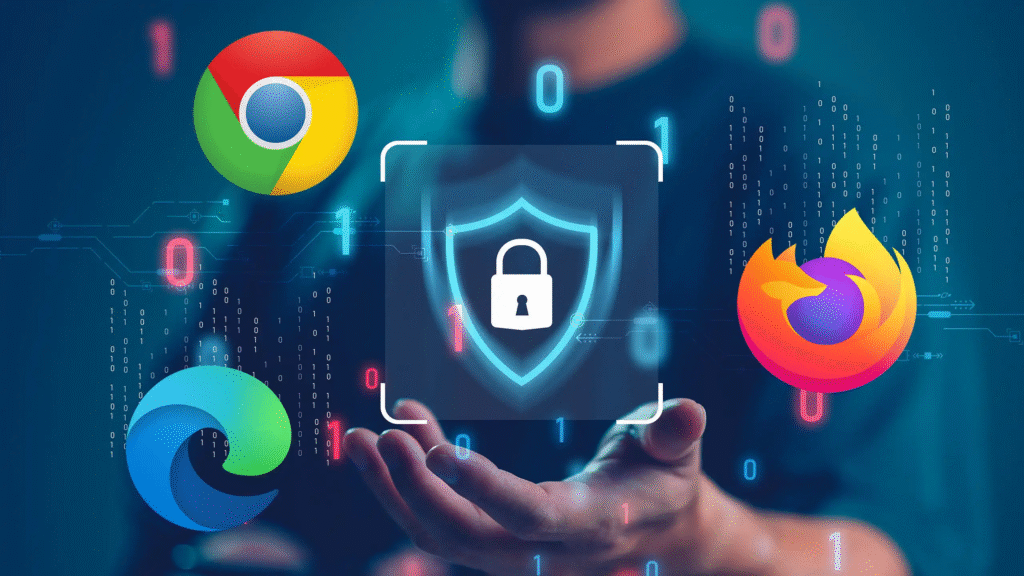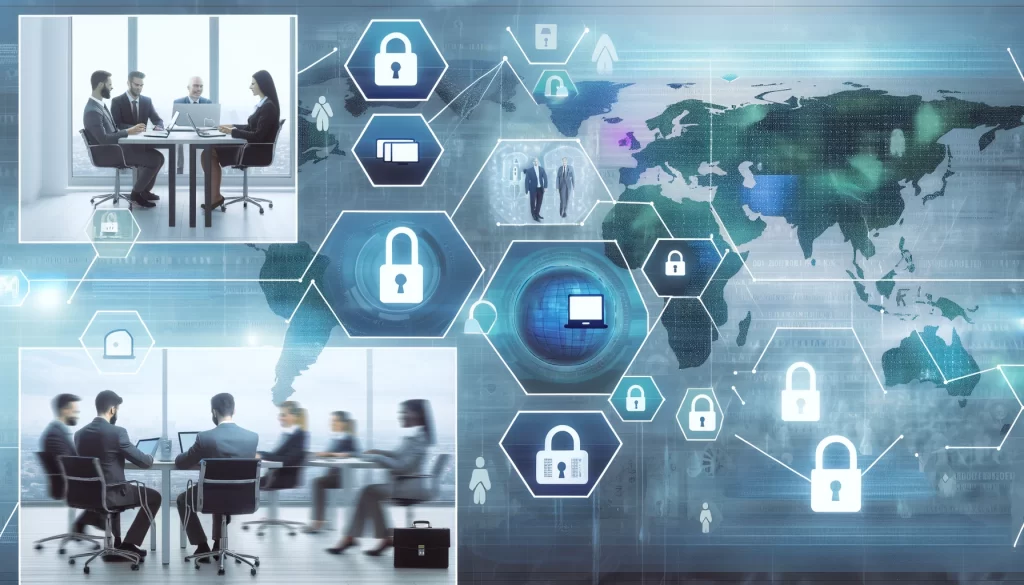Why Cybersecurity Matters More Than Ever
Let’s face it. Remote work is here to stay.
Whether you’re running a startup or working from your kitchen table, your team is online — sharing files, logging into accounts, and connecting from coffee shops and home networks.
But here’s the catch: more freedom = more risk.
Laptops can get stolen. Passwords can leak. Phishing emails are getting smarter.
Cybersecurity for remote teams isn’t just a tech thing anymore — it’s something every team needs to care about.
Did you know? Data breaches are more expensive when remote work is involved — adding over $130,000 in costs on average.
Tools That Help Keep Remote Teams Safe
Let’s keep this simple. You don’t need fancy tech — just the right tools in the right place.
1. VPN (Virtual Private Network)
Think of it as a privacy tunnel. It hides your internet activity, especially on public Wi-Fi.
Real-life use: Sarah logs into her company dashboard from a coffee shop. A VPN keeps her data safe from hackers.
Popular choices:
- NordVPN Teams
- ExpressVPN
- Perimeter 81
2. Password Managers

Stop using the same weak password for everything. These tools store and autofill secure passwords for all your accounts.
No more sticky notes. No more forgotten logins.
Top picks:
- 1Password
- Bitwarden
- LastPass
3. MFA (Multi-Factor Authentication)
MFA adds a second step to log in — like a code on your phone. Even if someone steals your password, they can’t get in.
It’s like a digital double lock.
Use it on:
- Slack
- Google Workspace
- Microsoft 365
- Zoom
4. Secure File Sharing
You’re already sharing files daily. Just make sure they’re safe.
Best secure platforms:
- Google Drive (Business)
- Dropbox Business
- Tresorit
Always check permissions. Only share what’s needed.
5. Device Protection (Endpoint Security)
Each laptop, phone, or tablet needs protection. If one gets hacked, it could affect your whole team.
Solid choices:
- CrowdStrike
- Bitdefender
- Sophos
6. Secure Messaging Tools
Not all chats are created equal. Use platforms that encrypt your conversations.
For sensitive discussions, tools like Signal are gold.
Other secure options:
- Microsoft Teams
- Slack (with security settings enabled)
Handy Checklist: Remote Team Security Essentials
💡 Tips That Actually Work (Best Practices)
1. Write a Simple Security Policy
Keep it short. Make it clear. Explain what tools to use and what to avoid. Share a quick “dos and don’ts” list.
2. Train Your Team Often
Cybersecurity isn’t just for IT people. Everyone needs to know the basics.
Try short videos, quizzes, or “what to do if” cheat sheets.
Tools to help:
- KnowBe4
- CyberHoot
3. Limit Access to Info
Not everyone needs access to everything. Give people only the access they need for their job.
For example: Your designer doesn’t need access to payroll files.
4. Do a Security Check-Up Every Quarter
Go through your tools and settings. Who has access? Are devices updated? What changed since last month?
Think of it like a routine health check — but for your team’s security.
5. Back Up Everything
Things break. Files get deleted. Backups can save your business.
Use encrypted backups stored on the cloud or offline.
6. Have a Game Plan
If something goes wrong, what should your team do? Write it down. Make sure everyone knows how to respond to things like a lost laptop or suspicious email.
Watch Out for These Common Threats
| Threat | What It Is | How It Happens |
| Phishing emails | Fake emails trying to steal info | “Reset your Zoom password here” |
| Malware | Harmful files disguised as safe ones | Clicking a fake invoice PDF |
| Weak passwords | Easy-to-guess or reused logins | Using “password123” or the same for all |
| Public Wi-Fi attacks | Hackers stealing data on public networks | Connecting without a VPN at the airport |
| Lost/stolen devices | Devices with no lock or encryption | Leaving your laptop in an Uber |
True Story: The Zoom Scam
A few remote teams got tricked by fake Zoom emails in 2023. The message looked real — “Your Zoom login needs to be verified.” Some employees clicked and entered their passwords. Just like that, hackers were in.
The fix? Train your team to always double-check links. When in doubt, don’t click.
Final Tips Before You Go-Cybersecurity for Remote Teams

- Keep devices updated
- Don’t mix personal and work devices
- Lock screens when you walk away
- Use tools your company approves
- Encourage people to speak up when unsure
FAQs – Cybersecurity for Remote Teams
1. What is the biggest cybersecurity risk for remote teams?
Answer:
The biggest risk is human error — like clicking a phishing email, using weak passwords, or not using security tools properly. Without an office IT team nearby, these small mistakes can lead to big problems.
2. Why is a VPN important for remote work?
Answer:
A VPN (Virtual Private Network) keeps your online activity private. It hides your data from hackers, especially on public Wi-Fi — like in airports, cafes, or co-working spaces. Every remote worker should use one.
3. How do I know if my team’s passwords are safe?
Answer:
If your team uses a password manager, keeps passwords strong and unique, and has multi-factor authentication (MFA) enabled, you’re on the right track. Avoid saving passwords in browsers or sharing them by email.
4. What tools are best for securing remote teams?
Answer:
Here are some of the best tools:
- VPNs: NordVPN Teams, Perimeter 81
- Password Managers: 1Password, Bitwarden
- MFA Apps: Google Authenticator, Authy
- File Sharing: Dropbox Business, Tresorit
- Device Protection: Bitdefender, CrowdStrike
- Secure Messaging: Microsoft Teams, Signal
5. Should we avoid public Wi-Fi while working remotely?
Answer:
Not necessarily — but always use a VPN if you’re working on public Wi-Fi. Otherwise, your sensitive data can be intercepted by cybercriminals on the same network.
6. What should we do if a device gets stolen or lost?
Answer:
Act fast. First, alert your IT team. Then remotely log out the user from all company apps and, if possible, wipe the device remotely. Always use device encryption and screen locks to limit damage.
7. How often should we train employees on cybersecurity?
Answer:
At least twice a year. Short, frequent trainings are better than long ones. Use real examples, phishing simulations, and quick checklists to keep everyone sharp.
8. Can remote teams really be as secure as office teams?

Answer:
Absolutely — if you use the right tools, build a security-first culture, and stay consistent with policies and training. In some cases, remote setups can even be more secure, with tighter controls and cloud-based tools.
9. What’s the difference between MFA and 2FA?
Answer:
They’re similar! 2FA means two steps to log in (like a password + SMS code). MFA means multiple factors — could be two, three, or more. MFA is just the broader term.
10. Is it okay to use personal devices for remote work?
Answer:
It’s risky — but common. If personal devices are allowed, make sure they:
- Have antivirus software
- Use a VPN
- Are updated regularly
- Separate work and personal accounts
A good policy and monitoring tools help reduce the risks.
